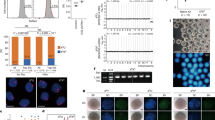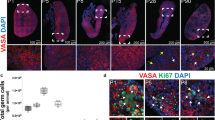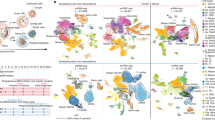Abstract
In normal sexual differentiation, XX germ cells develop into oocytes in an ovary, and XY germ cells undergo spermatogenesis in a testis. In some genetic abnormalities of sexual differentiation, and other abnormal situations such as experimental mouse chimaeras, XX germ cells may be present in a male embryo1,2. They will still migrate into the genital ridges, but in the environment of a testis they usually degenerate at or before the onset of meiosis. Whether they pursue a male or a female pathway of development before degeneration is not yet established. Very occasionally growing oocytes have been observed within seminiferous tubules, for example in a 16-yr-old hermaphrodite who was brought up as a girl and only came to medical attention because he wished to be recognised as a boy3. Such tubules usually form part of an ovotestis (refs 3–5 and P. S. Burgoyne, personal communication), though large numbers of primary and growing oocytes have also been observed in apparently normal testes of two mouse chimaeras, one an 8-d-old bilateral hermaphrodite (M. Spiegelman, personal communication) and the other a 5-d-old male6. The phenomenon is usually confined to very young animals, apart from one adult mouse chimaera (P. S. Burgoyne, personal communication) in which the tubules were disorganised and the oocytes that they contained were hyalinised, as though they had undergone atresia. In most cases (refs 3,5,6 and P. S. Burgoyne and M. Spiegelman, personal communications) the individuals were known to possess both an XX and an XY cell population, and the chromosomal sex of the oocytes was not established. In contrast, I report here that a substantial proportion of genetically sex-reversed male mice, in which all cells are initially XX in chromosome constitution, contained healthy growing oocytes within then- testes up to at least 15 days of age.
This is a preview of subscription content, access via your institution
Access options
Subscribe to this journal
Receive 51 print issues and online access
$199.00 per year
only $3.90 per issue
Buy this article
- Purchase on Springer Link
- Instant access to full article PDF
Prices may be subject to local taxes which are calculated during checkout
Similar content being viewed by others
References
Short, R. V. in The Genetics of the Spermatozoon (eds Beatty, R. A. & Gluecksohn-Waelsch, S.) 325–345 (Edinburgh and New York, 1972).
McLaren, A. Results and Problems in Cell Differentiation 9, 243–258 (1978).
Overzier, C. Klin. Wschr. 42, 1052–1060 (1964).
Bradbury, J. T. & Bunge, R. G. Fert. Steril 9, 18–25 (1958).
Tarkowski, A. K. J. Embryol. exp. Morph. 12, 735–757 (1964).
Mystkowska, E. T. & Tarkowski, A. K. J. Embryol. exp. Morph. 20, 33–52 (1968).
Cattanach, B. M., Pollard, C. E. & Hawkes, S. G. Cytogenetics 10, 318–337 (1971).
Paterson, H. F. J. Embryol. exp. Morph. 52, 115–125 (1979).
McLaren, A., Chandley, A. C. & Kofman-Alfaro, S. J. Embryol. exp. Morph. 27, 515–524 (1972).
Tarkowski, A. K. in Genetic Mosaics and Chimeras in Mammals (ed. Russell, L. B.) 135–142 (Plenum, New York, 1978).
Ożdżeński, W. Arch. Anat. Microsc. 61, 267–278 (1972).
Byskov, A. G. & Saxen, L. Devl Biol. 52, 192–200 (1976).
Ford, C. E. et al. Proc. R. Soc., B190, 189–197 (1975).
Evans, E. P., Ford, C. F. & Lyon, M. F. Nature 267, 430–431 (1977).
Lyon, M. F. in Physiology and Genetics of Reproduction, Part A (eds Coutinho, E. M. & Fuchs, F.) 63–71 (Plenum, New York, 1974).
Wachtel, S. S. & Ohno, S. Prog. med. Genet. 3 (1979).
Short, R. V. Brit. med. Bull. 35, 121–127 (1979).
Byskov, A. G. Ann. Biol. anim. Biochem. Biophys. 18, 327–334 (1978).
Byskov, A. G. Int. J. Androl., Suppl. 2, 29–38 (1978).
Author information
Authors and Affiliations
Rights and permissions
About this article
Cite this article
McLaren, A. Oocytes in the testis. Nature 283, 688–689 (1980). https://doi.org/10.1038/283688a0
Received:
Accepted:
Issue Date:
DOI: https://doi.org/10.1038/283688a0
This article is cited by
-
Female eggs grown in male testes
Nature (2005)
-
Fertile females produced by inactivation of an X chromosome of ‘sex-reversed’ mice
Nature (1982)
Comments
By submitting a comment you agree to abide by our Terms and Community Guidelines. If you find something abusive or that does not comply with our terms or guidelines please flag it as inappropriate.



